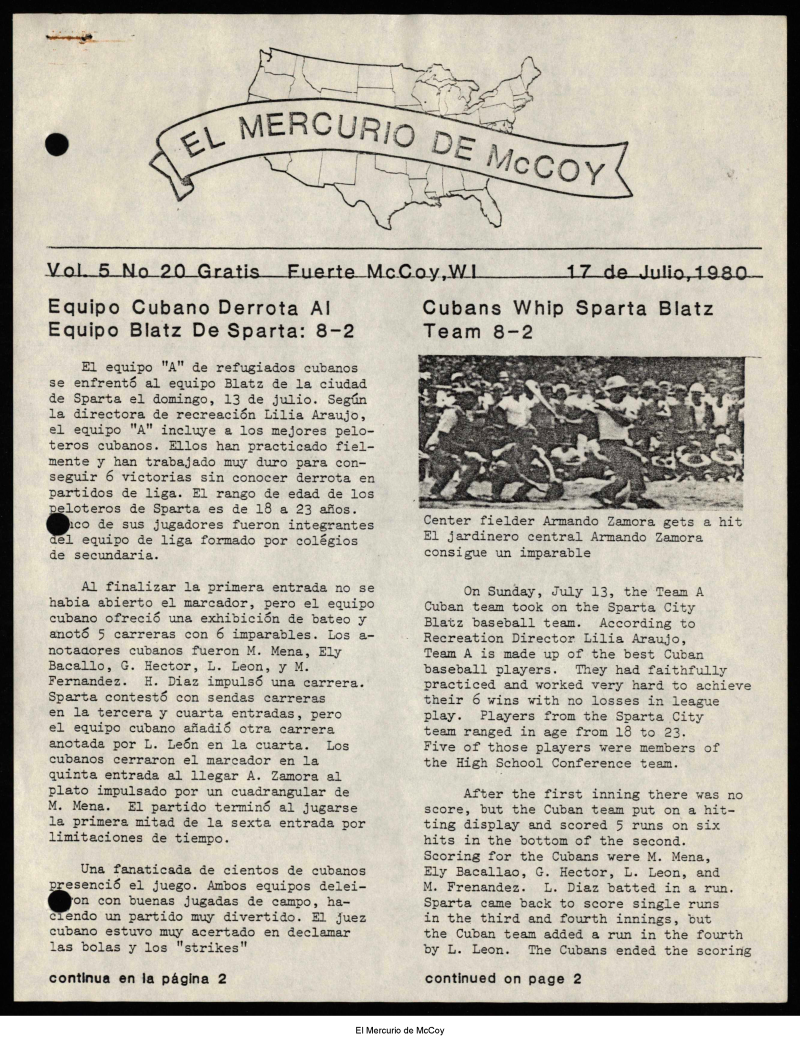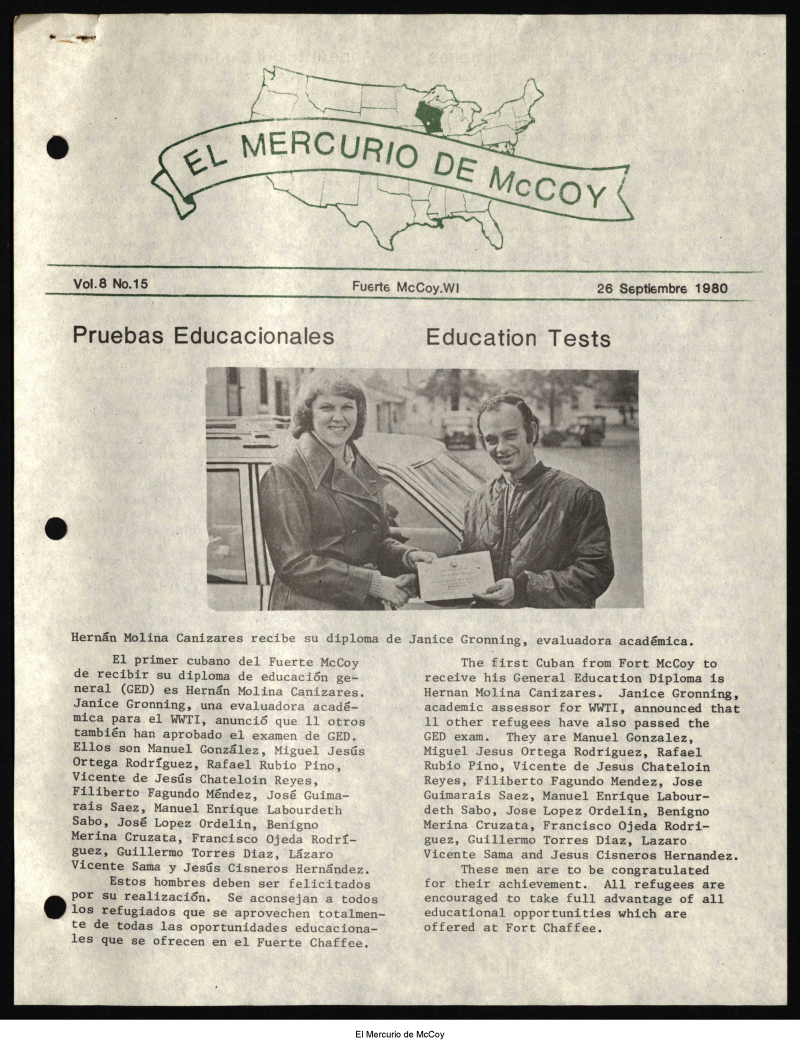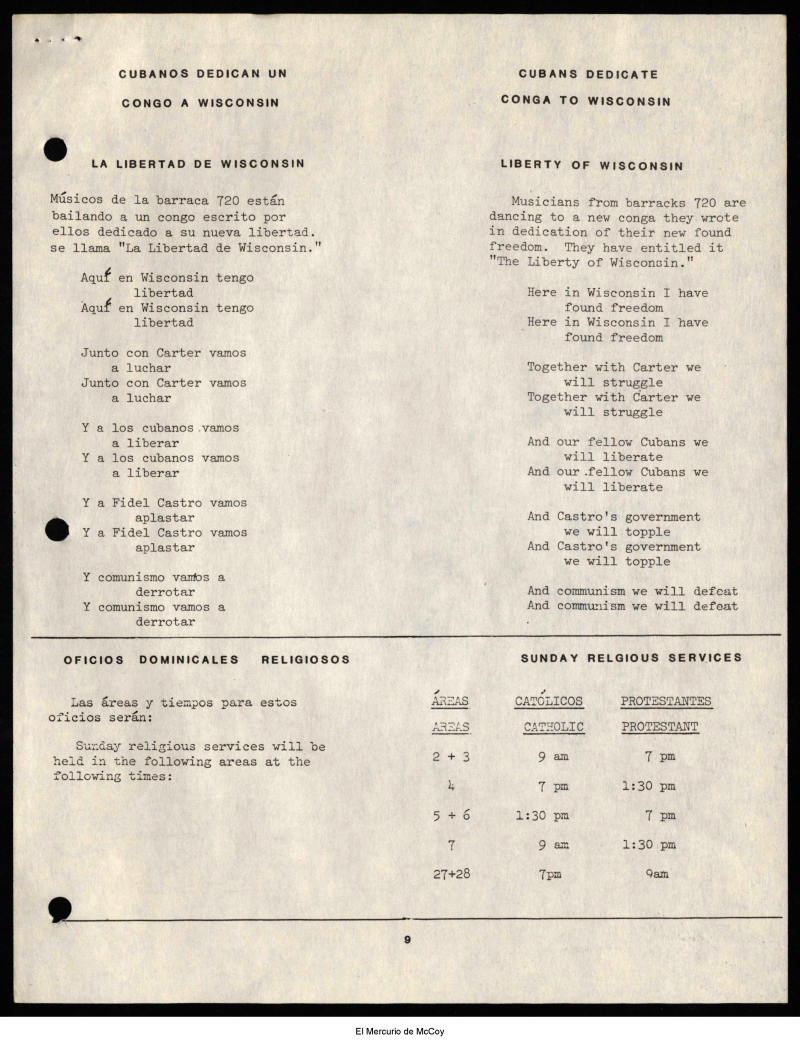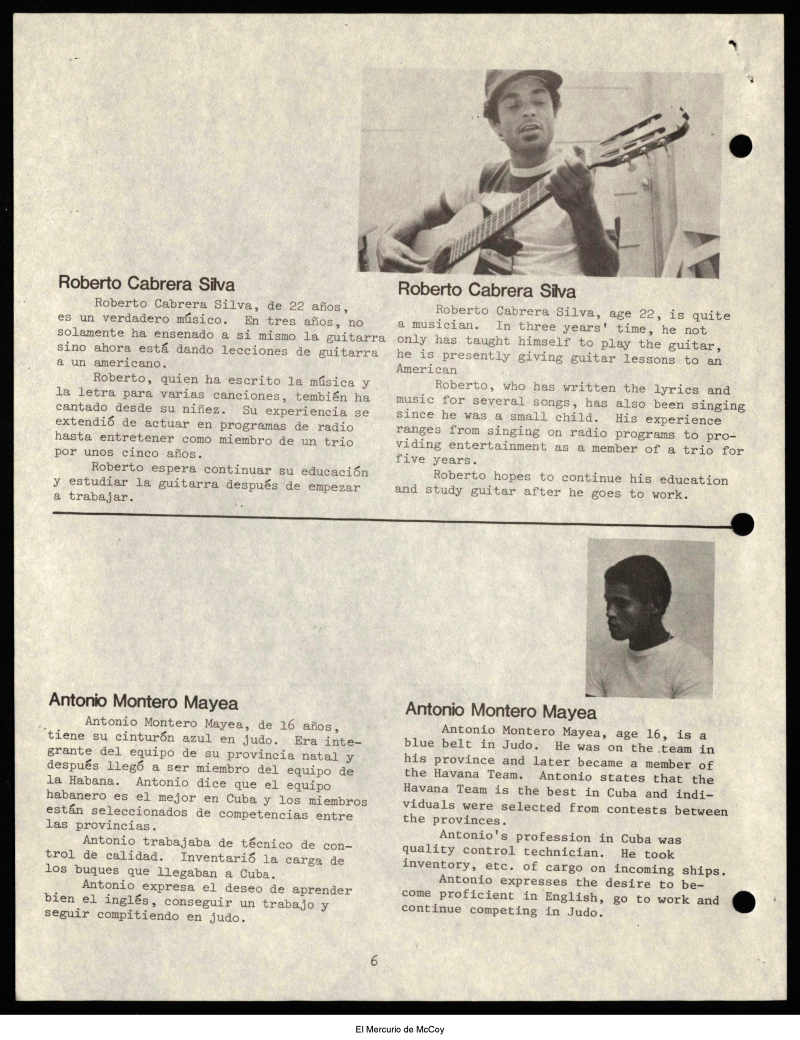
El Mercurio de McCoy
Each Mariel camp had a camp newsletter which was edited and printed in coordination between FEMA camp officers and the U.S. Civil Affairs Psychological Operations (CA/PSYOP) division in each compound. At Fort McCoy the publication was El Mercurio de McCoy. These publications were all bilingual with improvised translations by camp volunteers and interpreters. They offered, for the most part, the combination of FEMA’s intention to appease and educate refugees on immigration processing and, on the other hand, an officially-sanctioned refugee voice via editorials, cartoons, poems and refugee stories in the camp.
Cada campamento de Mariel tenía un boletín informativo que se editaba e imprimía en coordinación entre los oficiales de campamento de FEMA y la división de Operaciones Psicológicas de Asuntos Civiles de los Estados Unidos (CA/PSYOP) en cada recinto. En Fort McCoy, la publicación era El Mercurio de McCoy. Estas publicaciones eran todas bilingües con traducciones improvisadas por voluntarios del campamento e intérpretes. Ofrecían, en su mayor parte, la combinación de la intención de FEMA de apaciguar y educar a los refugiados sobre el proceso de inmigración y, por otro lado, una voz de refugiados oficialmente sancionada a través de editoriales, caricaturas, poemas e historias de refugiados en el campamento.
In the case of El Mercurio, the paper ran at Fort McCoy from June 3 until September 29, 1980 with a total of 53 issues, organized in eight volumes, at an average of eight pages per issue. It was printed in two or three colors, with some black and white photographic images. Many issues of El Mercurio exhibit a strong theme of the U.S. as a haven for oppressed refugees and focused on teaching Cubans about American history and culture or their civic duties as future Americans. The paper also brought daily English lessons and homework, sections on American geography, and basic health and common life advice which, at times, revealed a condescending tone from American authorities towards the Cuban migrants.
En el caso de El Mercurio, el periódico se publicó en Fort McCoy desde el 3 de junio hasta el 29 de septiembre de 1980 con un total de 53 números, organizados en ocho volúmenes, con un promedio de ocho páginas por número. Se imprimía en dos o tres colores, con algunas imágenes fotográficas en blanco y negro. Muchos números de El Mercurio muestran un tema dominante de los Estados Unidos como refugio para refugiados oprimidos, y se centran en enseñar a los cubanos sobre la historia y la cultura norteamericanas, o sus deberes cívicos como futuros estadounidenses. El periódico también ofrecía lecciones diarias de inglés y tareas, secciones sobre geografía norteamericana y consejos básicos de salud y vida cotidiana que, a veces, revelan un tono condescendiente de las autoridades norteamericanas hacia los refugiados cubanos.
Image courtesy of the UWL Murphy Library Digital Collections: Freedom Flotilla.
There was not a defined editorial policy or strategy for El Mercurio in terms of censorship or what content from outside should be published. El Mercurio, however, ignored controversial events in the compounds and did not offer a space for refugee writers to criticize their delayed detention or FEMA’s mismanagement of the camp or resettlements. Instead, El Mercurio published numerous editorials by both camp authorities and Cuban refugees which were aimed at appeasing Cubans and urged them to show gratitude for the Carter administration.
No existía una política editorial o estrategia definida para El Mercurio en términos de censura, o de qué contenido del exterior debería publicarse. El Mercurio, sin embargo, ignoraba los eventos más polémicos en el campamento y no ofrecía un espacio para que los escritores cubanos refugiados criticaran su demorada detención, la mala gestión de FEMA en el campamento y los procesos de reubicación. Por el contrario, El Mercurio publicaba numerosos editoriales tanto de las autoridades del campamento como de los refugiados cubanos que tenían como objetivo apaciguar a los cubanos y los instaban a mostrar gratitud hacia la administración de Carter.
Image courtesy of the UWL Murphy Library Digital Collections: Freedom Flotilla.
Cuban refugees who wrote for El Mercurio aimed to expose the discriminatory structures to which Mariel migrants were being subjected by the U.S. Government. As if these Cuban writers had been certain of the disparities that awaited Cubans outside Fort McCoy, they consistently featured positive personal profiles of Cuban migrants. The profiles emphasized either a successful education in Cuba, an artistic or athletic talent, a job skill newly acquired in the camp, and always insisted on clarifying any history of criminality in Cuba by explaining the unfairness of life under Castro. The profiles also detailed the future plans and hopes of young Cubans to succeed in American society.
Los refugiados cubanos que escribían para El Mercurio buscaban exponer las estructuras discriminatorias a las que los migrantes del Mariel estaban siendo sometidos por el gobierno de los EE. UU. Como si estos escritores cubanos hubieran estado conscientes de la discriminación que esperaba a los cubanos fuera de Fort McCoy, publicaban regularmente historias personales positivas de los migrantes cubanos. Estos perfiles personales enfatizaban una educación exitosa en Cuba, un talento artístico o atlético, una habilidad laboral recién adquirida en el campamento y siempre insistían en aclarar cualquier historia de criminalidad en Cuba explicando la injusticias de la vida bajo Castro. Los perfiles también detallaban los planes futuros y las esperanzas de los refugiados más jóvenes de tener éxito en la sociedad estadounidense.
Image courtesy of the UWL Murphy Library Digital Collections: Freedom Flotilla.
Besides featuring these personal profiles, El Mercurio underscored the networks of solidarity that developed among Mariel migrants and camp personnel. Numerous stories ran about the growing friendships between refugees, volunteers and soldiers, the subtext of which was often a narrative of interracial friendships between black Cubans and white Americans. Other stories in El Mercurio highlighted positive interactions of Cubans with Americans during field trips, sport competitions or cultural performances at nearby schools, churches and communities. Although the El Mercurio only circulated within the restricted perimeter of the camp, these reports attempted to offer a counternarrative to the sensationalist and negative tone of the news published by national media outlets about Mariel Cubans.
Además de presentar historias personales, El Mercurio enfatizaba las redes interraciales de solidaridad que se desarrollaban entre los migrantes del Mariel y el personal del campamento. Numerosas historias se difundieron sobre las amistades que se forjaban entre refugiados, voluntarios y soldados, cuyo subtexto era a menudo un comentario sobre amistades interraciales entre cubanos negros y estadounidenses blancos. Otras historias en El Mercurio destacaban las interacciones positivas de los cubanos con los estadounidenses durante excursiones escolares, competencias deportivas o representaciones culturales en escuelas, iglesias y comunidades cercanas. Aunque el periódico sólo circulaba dentro del perímetro restringido del campamento, estas historias ofrecían una narrativa opuesta al tono sensacionalista y negativo de los informes de la prensa nacional acerca de los cubanos del Mariel.
Last Updated Date
The La Crosse Public Library welcomes patron participation and comments on the La Crosse Public Library’s social media and in our online forums. All LPL online sites are governed by general rules of respectful civil discourse. Individual patrons are fully responsible for everything that they post.
The La Crosse Public Library does not discriminate against any views. However, we reserve the right to remove content that violates the below rules, without consent. We do not verify the identity of participants.
- The Library will remove:
- Off topic contributions
- Content that contains obscenity, nudity, defamation or hate speech (Speech that targets people or groups based on race, ethnicity, religion, gender, or any other protected status).
- Content that threatens to harm individuals, groups, or organizations
- Spam and content that promotes services or products, or that involves political campaigning or lobbying.
- Comments that give the appearance of legal, medical or financial advice.
- The Library may remove
- Content that contains personal information (whether your own or someone else's), including home address, home or cell phone number, or personal e-mail address, in order to protect privacy.
- Gratuitous links to sites.
- Repeat submissions of the same (or very similar) contributions will be viewed as spam and may result in the content being removed.
- The Library will only post content from participants over 13 years of age.
- Communications made through social media posts, e-mail, webinars, and messaging systems will in no way constitute a legal or official notice or comment to the La Crosse Public Library or any official or employee of the Library for any purpose.
- All user-generated content is released into the public domain unless the participant clearly states otherwise,
- Users who do not comply with these standards of conduct may be blocked.
Disclaimer for links posted on our Website or Social Media
External links are being provided as a convenience and for informational purposes only; they do not constitute an endorsement or an approval by the La Crosse Public Library of any of the products, services or opinions of the corporation or organization or individual. The La Crosse Public Library bears no responsibility for the accuracy, legality or content of the external site or for that of subsequent links. Contact the external site for answers to questions regarding its content.
Reviewed and approved by Library Board, November 2021



